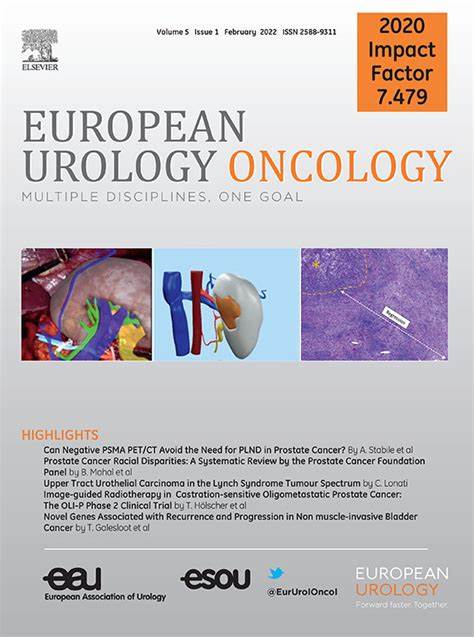前列腺活组织检查中使用人工智能靶向b型经直肠超声检测前列腺癌。
IF 8.3
1区 医学
Q1 ONCOLOGY
引用次数: 0
摘要
背景与目的:利用人工智能方法评估常规经直肠前列腺亮模(b)超声图像是否能显示有临床意义的肿瘤。方法:本研究包括2986名在两个机构接受活组织检查的男性。我们在b型经直肠超声图像网络(ProCUSNet)上训练前列腺癌检测,以确定超声是否能够可靠地检测癌症。具体来说,ProCUSNet基于完善的nnUNet框架,旨在通过从2D屏幕截图重建的三维(3D)检查来检测和概述具有临床意义的癌症。我们将ProCUSNet与(1)参考标签(n = 515例患者),(2)8名解读b超的阅读器(n = 20-80例患者),以及(3)临床护理中解读磁共振成像(MRI)的放射科医生(n = 110例根根性前列腺切除术患者)进行了比较。主要发现和局限性:ProCUSNet发现82%具有临床意义的癌症病例,病变边界误差高达2.67 mm,比超声阅读器多检测出42%的病变(灵敏度:0.86 vs 0.44, p 0.05, Wilcoxon检验,Bonferroni校正),同时具有作为系统活检补充的相同靶向功能。结论和临床意义:ProCUSNet可以在屏幕捕捉b超上定位临床重要的癌症,这对于临床医生来说是一项特别具有挑战性的任务。作为系统活检的补充,ProCUSNet似乎可以与MRI相媲美,表明其在活检过程中针对可疑病变的实用性,并且可能在没有MRI的情况下仅使用超声进行筛查。本文章由计算机程序翻译,如有差异,请以英文原文为准。
ProCUSNet: Prostate Cancer Detection on B-mode Transrectal Ultrasound Using Artificial Intelligence for Targeting During Prostate Biopsies
Background and objective
To assess whether conventional brightness-mode (B-mode) transrectal ultrasound images of the prostate reveal clinically significant cancers with the help of artificial intelligence methods.
Methods
This study included 2986 men who underwent biopsies at two institutions. We trained the PROstate Cancer detection on B-mode transrectal UltraSound images NETwork (ProCUSNet) to determine whether ultrasound can reliably detect cancer. Specifically, ProCUSNet is based on the well-established nnUNet frameworks, and seeks to detect and outline clinically significant cancer on three-dimensional (3D) examinations reconstructed from 2D screen captures. We compared ProCUSNet against (1) reference labels (n = 515 patients), (2) eight readers that interpreted B-mode ultrasound (n = 20–80 patients), and (3) radiologists interpreting magnetic resonance imaging (MRI) for clinical care (n = 110 radical prostatectomy patients).
Key findings and limitations
ProCUSNet found 82% clinically significant cancer cases with a lesion boundary error of up to 2.67 mm and detected 42% more lesions than ultrasound readers (sensitivity: 0.86 vs 0.44, p < 0.05, Wilcoxon test, Bonferroni correction). Furthermore, ProCUSNet has similar performance to radiologists interpreting MRI when accounting for registration errors (sensitivity: 0.79 vs 0.78, p > 0.05, Wilcoxon test, Bonferroni correction), while having the same targeting utility as a supplement to systematic biopsies.
Conclusions and clinical implications
ProCUSNet can localize clinically significant cancer on screen capture B-mode ultrasound, a task that is particularly challenging for clinicians reading these examinations. As a supplement to systematic biopsies, ProCUSNet appears comparable with MRI, suggesting its utility for targeting suspicious lesions during the biopsy and possibly for screening using ultrasound alone, in the absence of MRI.
求助全文
通过发布文献求助,成功后即可免费获取论文全文。
去求助
来源期刊

European urology oncology
Multiple-
CiteScore
15.50
自引率
2.40%
发文量
128
审稿时长
20 days
期刊介绍:
Journal Name: European Urology Oncology
Affiliation: Official Journal of the European Association of Urology
Focus:
First official publication of the EAU fully devoted to the study of genitourinary malignancies
Aims to deliver high-quality research
Content:
Includes original articles, opinion piece editorials, and invited reviews
Covers clinical, basic, and translational research
Publication Frequency: Six times a year in electronic format
 求助内容:
求助内容: 应助结果提醒方式:
应助结果提醒方式:


